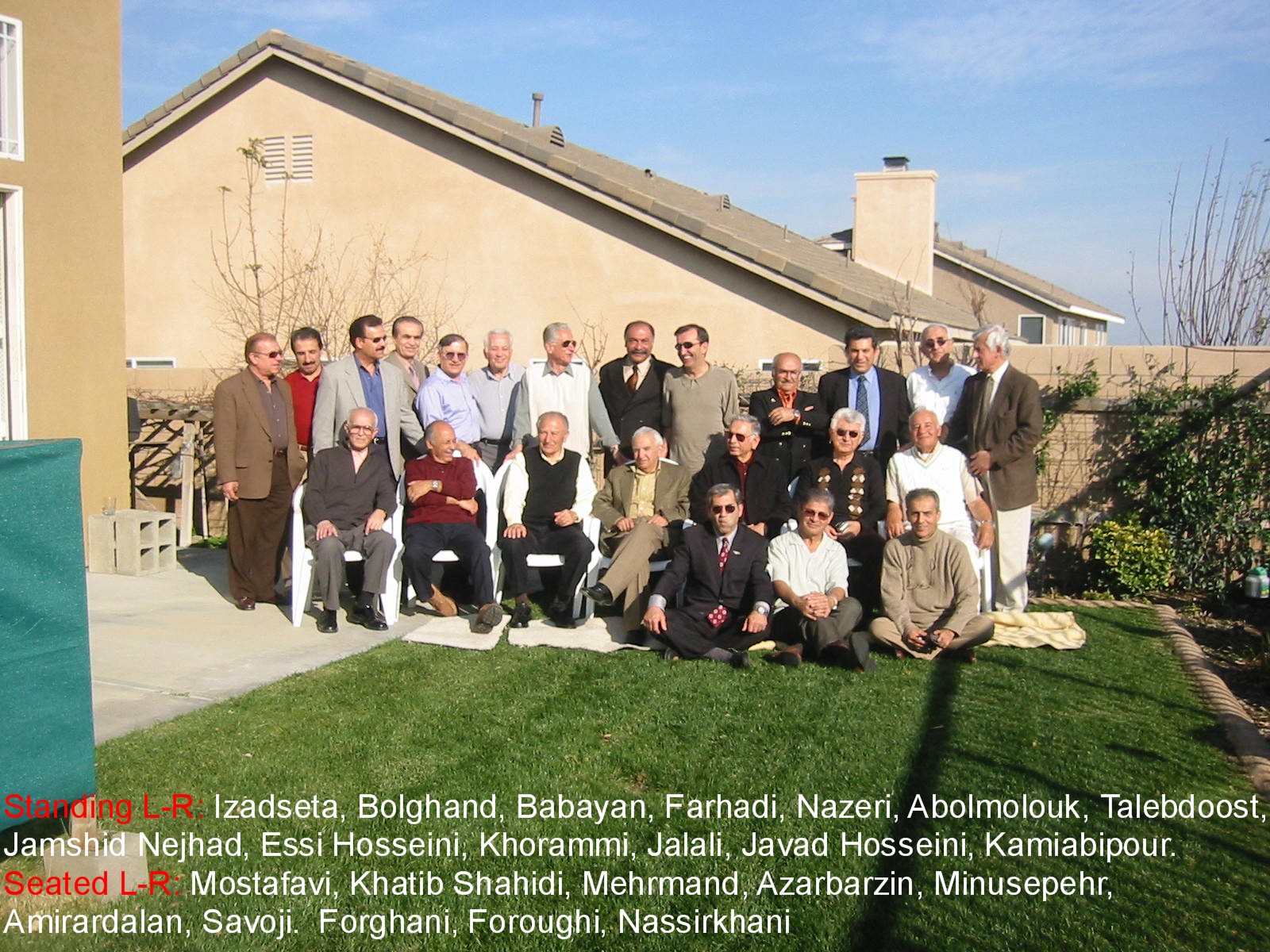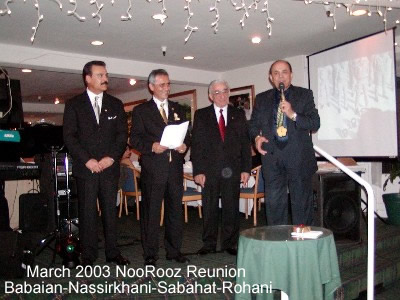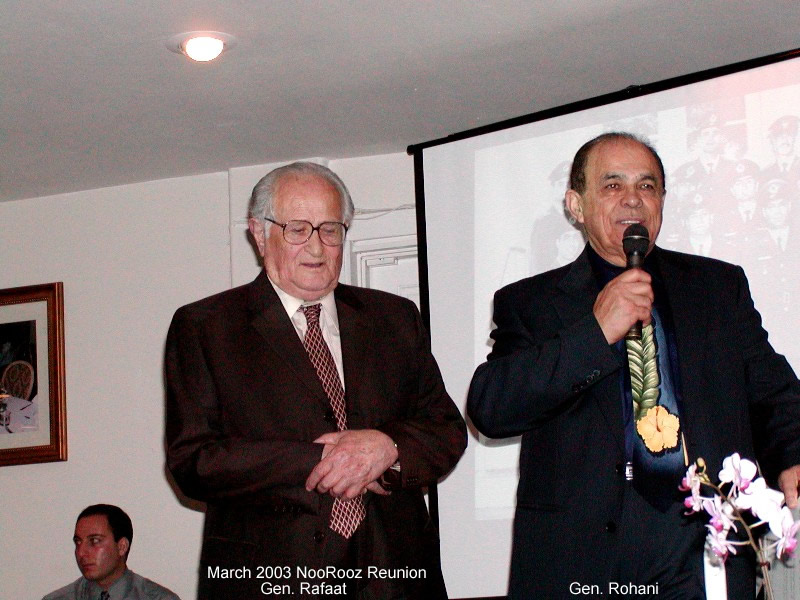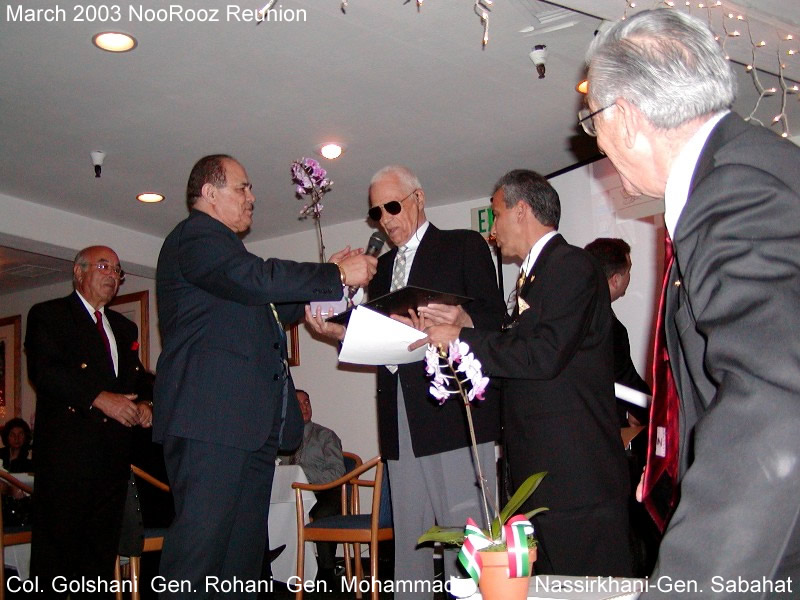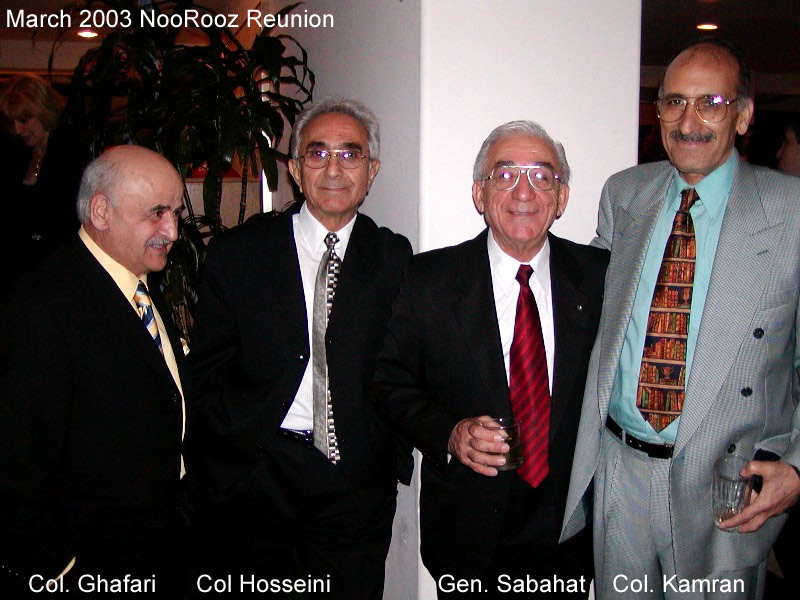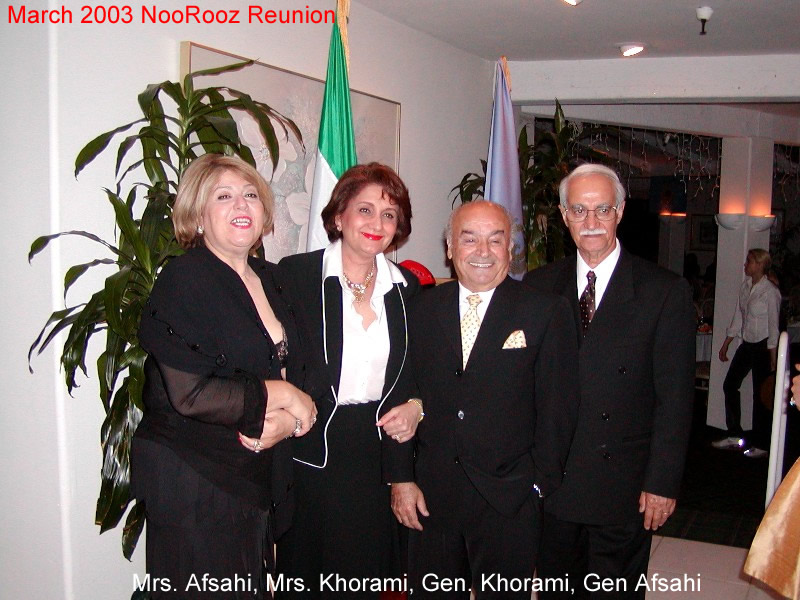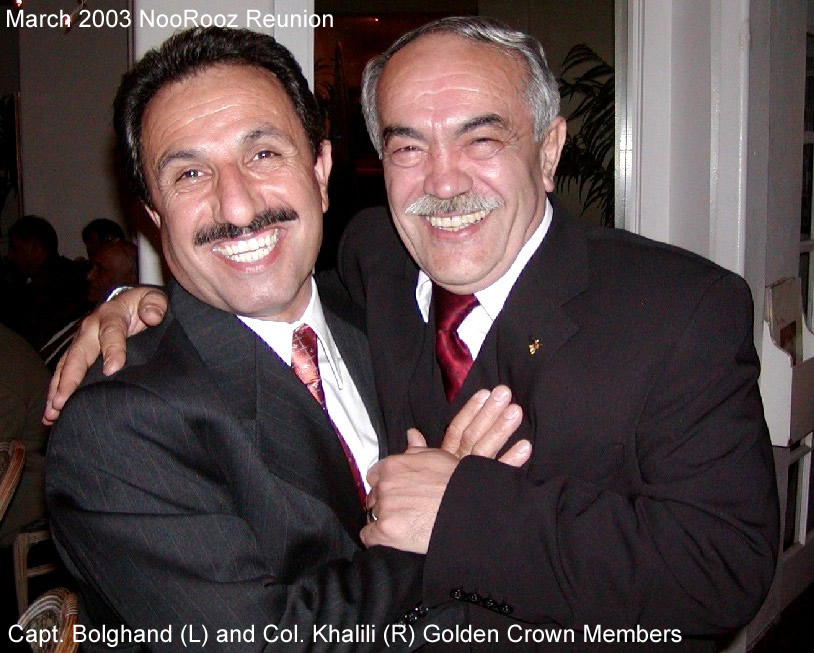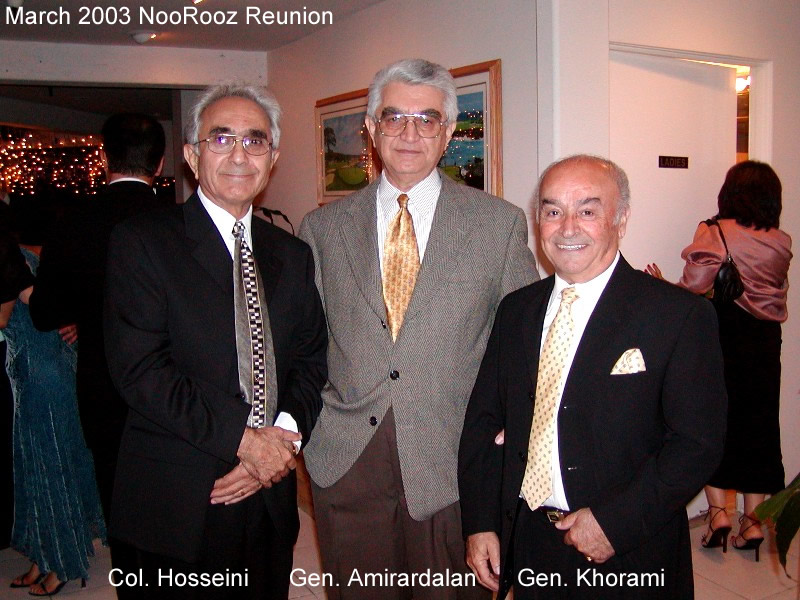 |
 |
|
============================================ This article is dedicated to every Iranian pilot who never came home. The only place in the world that their memory is collectively honored is http://www.iiaf.net/stories/warheroes/warheroes.html The one who does good deeds and expects to be
appreciated, does something better then committing a bad deed.
However, he does so for his own benefit and not for others.
A truly righteous man does good deeds without letting his
beneficiary know of his deeds. He does good deeds freely and
does not expect that in the future someone will recognize
his deeds. A monk must have resolve far greater then this.
In treating all sentient beings, he must not discriminate
between those who are close to him and those who are scarcely
known to him. Many great powers throughout history have had a special class of warrior, known for their bravery, chivalry, and honor. The British have had their knights, the French their chevaliers, but perhaps the most prominent symbol of the noble warrior has been the Japanese Samurai. The Samurai were a special class of warrior who were absolutely dedicated to their emperor and their country. They were legendary for their strength, dedication to perfection and training in the arts of war, and most importantly, for the Samurai code, also known as Bushido. One can spend a lifetime studying this code and the Samurai way, and still not fully understand it. The way of the Samurai is one of absolute dedication, selflessness, honor, bravery and fierceness to one’s enemy, mercy and compassion towards the weak, and preference of death over shame. A Samurai would often take his own life rather than accept defeat or dishonor, and there was a solemn ritual for this. Dishonor includes the committing of crimes against civilians and non-participants in battle, no matter how weak a position the Samurai found himself in. The Samurai way was also a simple one, in which wealth and worldly possessions were not to be accumulated. While they were not religious or holy warriors, they did practice Zen Buddhism, and meditated in order to clear their mind. Samurai also would never glorify themselves individually. Praise could only come from their peers. Samurai would also never enter battle expecting reward, their main reward was honor itself. While the Samurai no longer practically exist since Japan’s forced modernization in the late 19th century, the way of the Samurai lives on in the hearts and minds of her people. We Iranians also have had such a class in our history since thousands of years ago. They are called “Pahlavan”. They also have a very similar code to the Samurai, in which emphasis is placed on training hard, behaving honorably, and showing mercy and compassion to the weak. In Farsi, we know this through the term “javanmardi”, which has no good translation in English. The closest English I can think of is chivalry. The Pahlavan tradition had to be modified over the years, especially after the Arab invasion and subsequent conversion to Islam of Iran, but the essence has stayed the same. The “zoorkhaneh” in which they train dates back to at least 2000 years ago. In fact, it is so old that nobody is sure of when its first occurrence was. Why am I saying all this? Well, many people think that these are obsolete ways of the past, and their values no longer apply in the era of modern technology. I disagree strongly. These values are perhaps more necessary than ever today, in a world where profit and power have come to overshadow the concept of duty and honor. Technology has very often merely aided the more ruthless pursuits by those who are hungry for power or profit, whether it is to control their society through the use of religion, or to use force to obtain cheaper energy and resources in the name of democracy. As an Iranian, I am proud to state that one of the few examples of the Samurai way surviving today can be found in our most recent history. I am referring to the defense of our homeland by our neglected and abused air force in the 1980’s in the face of a heavily armed Iraq. I don’t mean to ignore our ground and naval forces, but I specifically mention our air force for a reason. The Iranian Air Force was the force most heavily paid attention to before 1979, and therefore bore the brunt of the mullahs’ carnage upon their assuming power. Within days of the new government, top commanders whose only crime was their service to their country were executed after mock trials. Thousands of competent pilots and officers would face similar fates as the months went by. The late General Nader Jahanbani, who was one of the fathers of Iranian aviation and one of the best fighter pilots in the world, faced his captors in true Samurai fashion, and maintained his loyalty to his country and the crown by refusing to serve the mullahs. General Jahanbani had all his life pushed young Iranian pilots to be the best, and as early as 1958 formed the Iranian Air Force Acrojet team, performing right up there with the US Navy Blue Angels and US Air Force Thunderbirds. The few other countries in our region who were able to ever accomplish such a task would not do so until over 40 years later. General Jahanbani was executed immediately, and he died rather than accept dishonor. Similar fates were met by legends of our country like General Mohagheghi and other innocent soldiers of our people. Their memory will be honored by all those in our and future generations who love their country Iran. On September 22, 1980 Saddam Hussein invaded an incredibly weakened Iran, encouraged by those who made Iran weak and other enemies of Iran. Together, they understandably calculated that the Iranian military had collapsed, and that what was left of the “Shah’s Armed Forces” would refuse to fight under the new regime. Their calculation was arithmetically correct. They just failed to understand one thing- the way of the Samurai. And for that, they paid dearly. Many Iranian airmen who were expelled (and even jailed) from the air force by the new regime would plead to be allowed to fly and defend their country, but were turned down. Those who were allowed to live and serve their country did so magnificently in the face of an Iraqi invasion, hostile regime, international isolation, and embargo. In the first 2 months of the war, they virtually single handedly pounded and stopped the Iraqi invasion as Iran had no army. These heroes would have been recognized and rewarded for doing a lot less in other countries. But in ours, some were subsequently expelled or even executed secretly by the mullahs during wartime when we so desperately needed them. At best, they were just left alone. Sadly, our nation barely even knows of the existence of such people, let alone their names and stories. Because of their honorable actions, dedication to their country, and incredible bravery, these gentlemen were truly our Samurai in the sky. As usual in our history, it takes a non-Iranian to research this story and become fascinated by it. The story of these brave Samurai in the sky is continuously being researched and recorded by military historians, Tom Cooper and Farzad Bishop in a series of books. Once, Mr. Cooper was asked what made him interested in this subject. His response was that after studying many other military conflicts, he had never seen this level of sacrifice by any force under even close to such conditions. In most other countries, the pilots would have refused to fly merely on grounds of safety, and it would have been acceptable and honorable. In most other countries, these warriors in the sky would have been recognized much louder for doing much less in a much shorter time. The Iranian pilots who have actually survived this war spent eight years fighting, and this is unheard of. No jet fighter pilot in the world has as much combat experience as these men. Sadly, the surviving pilots left behind many comrades lost to Saddam’s Russian and French made surface to air missiles, and are now dying young as they aged so quickly under such massive stress. All for their country, honor, and out of complete selflessness. Mr. Cooper also observed once that he has never seen an Iranian pilot brag about his own accomplishments, but rather always tell of the great accomplishments of his colleagues (even though his colleagues were doing the same for him!). He was able to get all his information through extensive research, including interviews with veterans of this war from both sides, without ever traveling to Iran. This is because many of the survivors and veterans of the air war now live abroad. The regime no longer needs them and would easily imprison and execute them for various “crimes”, let alone provide them with a safe comfortable retirement in their homeland after all they have done. Just a few lesser known examples of the bravery of these men: -Major Bahram Ilkhani was a reconnaissance pilot, whose mission was to take pictures of the enemy from a fast, unarmed plane called the RF-4E. Iran had some of the best such pilots in the world before 1979, and he was one of them. After flying over several heavily defended positions in Iraq and sustaining several missile hits, he flew back towards Iran at full speed at an altitude of 50 meters, violating every safety rule so he could escape. He flew so low and fast that one of the Iraqi Mig’s chasing him couldn’t match his skill and crashed! As he was losing fuel from the numerous holes in his tanks, it became clear that he couldn’t make it back to the Iranian border without refueling. One of the large tanker aircraft waiting for his arrival at the Iranian border then disobeyed orders and flew into Iraq and met him to refuel at that low altitude. Nobody has ever done such a thing before, in Vietnam, the Middle East, or anywhere. Major Ilkhani made it back with the valuable information and 17 holes in his airplane. The information was used to obtain a major victory on the ground shortly afterwards. Major Ilkhani however, was not to survive the war as the regime executed him on vague charges. He did his duty in true Samurai fashion. May he rest in peace.
-Major Jalal Zandi , an F-14 pilot, shot down 9 Iraqi fighters throughout the war, making him the most accomplished F-14 pilot in the world, and one of the greatest jet fighter aces in history. He died of a heart attack in 2001 very young. Normally, a pilot is not put into combat for more than 6 months to 1 year (the longest tours were in Vietnam and Korea). Pilots like Major Zandi fought for eight years, against an enemy over 6 times their size! -Major Yadollah Javadpour is one of the most accomplished F-5 pilots in the world, and flew in the Acrojet team founded by General Jahanbani. The F-5 is a light, low cost fighter, and Major Javadpour shot down 5 Iraqi fighters, making him one of the prominent jet fighter aces in history. One of his victims was the Mig-25, the world’s fastest fighter, and at the time the Russians’ most advanced fighter, flown by Colonel Rayyan, Iraq’s top fighter pilot. The downing of a fighter like the Mig-25 by an F-5 is unprecedented in the history of air combat, and Major Javadpour has become a legend in the worldwide F-5 pilot community. There are many more stories like these, and Mr. Cooper and others are researching heavily to try to keep these stories preserved. In this war, Iran fought under terrible domestic and international conditions. The Iraqis were constantly resupplied and supported with AWACS and satellite intelligence, weapons, money, and logistics from the Gulf Arab states and all the superpowers. They even used pilots from numerous other countries, including Egypt, the Soviet Union, East Germany, Belgium, and South Africa. Yet in the air to air arena, Iran produced many aces and achieved a kill ratio of over 5:1, one of the best such ratios in the history of air warfare. The Iranian Air Force pilots would avoid civilian targets at all costs and at great risks to themselves, while Iraqi pilots would shamelessly bomb innocent civilians, sometimes even with chemical weapons. So what happened to our Samurai of the sky? From day 1, the odds were against them. Many would not survive, as they would fly dangerous and suicidal missions against heavily defended Iraqi territory. (Please see a list here: http://www.iiaf.net/stories/warheroes/warheroes.html) Many others would be executed or purged by the regime. Of those who survived the war and the regime, many live abroad (some in very unfortunate conditions) as they have done their job already and are not safe in Iran. A few are still in Iran. Sadly, they have little other outlet than each other and a few websites to discuss their stories, as their epic has been kept from the Iranian people. Occasionally, the regime will commemorate a few air force members who were hezbollahi, and give them massive credit, while completely ignoring those who did all the incredible sacrifice for their country in true Samurai fashion. The Iranian Armed Forces were the undisputed power in our region under the Shah. He spared no compromise in obtaining the best training and equipment in the world for these forces in the era of the cold war, with the Soviets to our north, the Arab-Israeli and Indo-Pakistani conflicts at our doorstep. In such an environment, we had peace, prosperity, and stability. And when the time came, our armed forces proved their amazing skill and courage in action and saved our country, which we owe to them today. There are many reasons to be proud of being Iranian. Our thousands of years of history have given us giants like Kourosh, Ferdosi, Kaveh, Arash, Babak, Khayyam, Hafez, Saadi, Ibn-e-Sina, Amir Kabir, you name it. While we were often near mortally wounded, we stood fast in the face of invasions of barbarians, and kept our language, culture, and identity. But after reading about our pilots and their sacrifices, and the punishment they received in place of reward, I can say this is one of the biggest sources of pride for me as an Iranian. At the same time it is a great source of sorrow and shame for me that after all they have done and given for their homeland, so many of them are not able to retire safe and comfortably in their own country, and their nation does not even know about their existence or names or stories, let alone appreciate and honor them. I can also say that the Samurai and the Pahlavan way is far from dead, and that these people were our Samurai in the sky. They gave everything, and they did so honorably in the face of certain death, and expected (and got) nothing in return. Today, there is no monument to honor these amazing
people of our history. There is no remembrance or memorial
to them. The only place that you can find a mention of them
all in one place is at http://www.iiaf.net/stories/warheroes/warheroes.html,
which is a work in progress. It is up to us who are left behind
to remember them and honor their bravery and sacrifice, as
they took (and continue to take) their last and greatest flight.
Only then can we call ourselves honorable as well.
================================================= |

